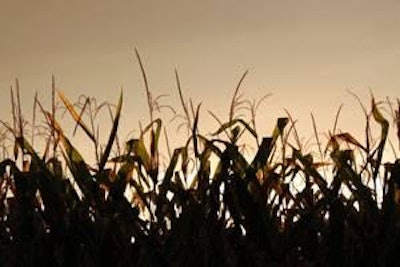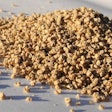
In 2008, U.S. production of distiller’s dried grains with solubles, or DDGS, exceeded 23 million tons with the U.S. poultry industry consuming about 5% of output and swine producers feeding around 20% of available DDGS. The majority of DDGS is fed to ruminants at rates of 75% to 80% of their diets.
The production of DDGS will increase in proportion to ethanol production; for the 2011 growing season, ethanol will consume 40% of the corn crop. With increasing production, DDGS will have to be used to a greater extent by livestock and poultry producers to replace diverted corn and more expensive soybean meal.
Previous research on DDGS in laying hens showed no negative effect on egg production when fed at 10% to 20% of diets. DDGS can contribute as much as one-third of the protein needs of laying hens. The protein concentration in DDGS is approximately three times the level in corn due to removal of fermentable carbohydrate and starch. DDGS is high in total phosphorous and nitrogen compared to corn, and can consequently reduce the amount of inorganic phosphorous added to hen diets. Inclusion of DDGS does not affect excretion of nitrogen in manure.
Exogenous enzymes such as phytase and combinations of amylase, protease and carbohydrase are incorporated more frequently into poultry diets especially during times of high commodity prices. The majority of research on the efficacy of enzymes has been conducted on corn or wheat-based diets with soybean meal as the major protein source. The action of these enzymes in diets with a high level of DDGS has been a focus of the University of Nebraska-Lincoln research program in poultry diets for the last three years.
Research objectives on DDGS in poultry diets, 2007-2010:
- To evaluate high inclusion of DDGS in feed for laying hens over a production cycle
- Determining the maximum inclusion rates of DDGS in layer diets supplemental with Alltech SSF
- Examining synergies from DDGS and meat and bone meal with enzyme supplementation in layer diets
Ascertaining the maximum inclusion level of DDGS in layer rations
When DDGS was incorporated in experimental diets, synthetic lysine and a fat blend were added. Dicalcium phosphate was decreased with incremental DDGS levels in diets. Feeding 25% DDGS to laying hens saved $20.92 and $9.92 per ton for Phase I and Phase II compared to diets devoid of DDGS.
In this initial study, results indicated that feeding corn with DDGS at levels of up to 25% had no negative effect on egg production parameters during either Phase. Feeding DDGS at 20% and 25% affected egg weight in Phase I but not in Phase II. This was due to changing the amino acid balance from fixed lysine and total sulphur-containing amino acids in Phase I to fixed lysine and TSAAs during Phase II.
Feeding high inclusion rates of DDGS is possible if amino acid balance is achieved. In addition, DDGS can replace some dicalcium phosphate in layer diets to reduce feed cost. The reduction in nitrogen and phosphorous excretion were positive benefits of feeding high levels of DDGS.
Effects of feeding DDGS with SSF enzyme
This trial was conducted on laying hens which were fed 0%, 10%, 20%, 30% or 40% DDGS with or without Allzyme SSF (Alltech) enzyme in a factorial arrangement. Diets were formulated to be isocaloric and isonitrogenous. When SSF enzyme was added to the diets, metabolizable energy was reduced by 75 kcal/kg.
Results of the long-term trial indicated a slightly lower level of egg production and egg mass at the 40% level of DDGS inclusion. Diets with SSF enzyme fully supported production equal to hens in the treatments without enzyme supplementation. Adding Allzyme SSF enzyme saved an average of $8.00/ton of feed, and feeding up to 30% DDGS saved $64.00/ton of feed compared to the basal diet devoid of DDGS, based on 2010 ingredient costs.
Synergy of feeding DDGS and meat and bone meal with enzyme combinations (Phytase + Avizyme)
The objective was to test the addition of Avizyme 1502, a blend of protease, amylase and xylanase (Danisco UK Ltd.) and a phytase in laying hens fed corn-soy diets containing DDGS, meat and bone meal. Hy-Line W-36 laying hens were used in the study, which was conducted from 24 to 52 weeks of age. There were 12 replicate pens with four hens per pen, with 96 pens in total.
The study consisted of eight dietary treatments arranged in a 2x2x2 factorial design. The factors were: diet (containing DDGS or MBM), metabolizable energy level 2930 Kcal/kg (Phase 1), 2880 Kcal.kg (Phase 2) or 2860 Kcal/kg (Phase 1), 2800 Kcal.kg (Phase 2), and two enzyme levels (0 or 0.0375% Avizyme 1502) to provide protease at 8000 U/g, amylase at 800 U/g, and xylanase at 600 U/g of product. All diets contained Phyzyme at 60 g MT (~300 FTU) and were formulated to contain 0.30%.
The bottom line
DDGS can be included at relatively high levels in diets for pullets and laying hens when formulated to balance amino acid requirements. Addition of exogenous enzymes allows downgrading of dietary specifications for diets containing MBM and DDGS. Exogenous enzyme supplementation can significantly reduce the cost of diets for laying hens.
Adapted from a presentation made at the 2011 Midwest Poultry Federation Convention.






